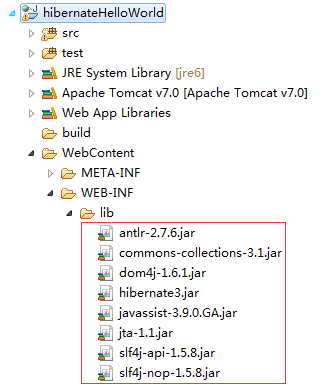标签:
hibernate 环境的配置步骤:
加入 hibernate 所需的 jar 包,并将这些 jar 添加到 project 中,如图:

hibernate.cfg.xml 的建立。hibernate 的 hibernate.cfg.xml 配置文件默认在 project/src 目录下,如图:

hibernate.cfg.xml 中的内容如下(当然,这是从 hibernate 的参考文档中拷贝过来的,还未修改):
<?xml version=‘1.0‘ encoding=‘utf-8‘?> <!DOCTYPE hibernate-configuration PUBLIC "-//Hibernate/Hibernate Configuration DTD 3.0//EN" "http://hibernate.sourceforge.net/hibernate-configuration-3.0.dtd"> <hibernate-configuration> <session-factory> <!-- Database connection settings --> <property name="connection.driver_class">org.hsqldb.jdbcDriver</property> <property name="connection.url">jdbc:hsqldb:hsql://localhost</property> <property name="connection.username">sa</property> <property name="connection.password"></property> <!-- JDBC connection pool (use the built-in) --> <property name="connection.pool_size">1</property> <!-- SQL dialect --> <property name="dialect">org.hibernate.dialect.HSQLDialect</property> <!-- Enable Hibernate‘s automatic session context management --> <property name="current_session_context_class">thread</property> <!-- Disable the second-level cache --> <property name="cache.provider_class">org.hibernate.cache.NoCacheProvider</property> <!-- Echo all executed SQL to stdout --> <property name="show_sql">true</property> <!-- Drop and re-create the database schema on startup --> <property name="hbm2ddl.auto">update</property> <mapping resource="org/hibernate/tutorial/domain/Event.hbm.xml"/> </session-factory> </hibernate-configuration>
至此,hibernate 环境配置完成。
hibernate 与 mysql 集成:
添加支持 mysql 驱动的 jar 包,如下图:

2. 修改 hibernate.cfg.xml
<!-- Database connection settings --> <property name="connection.driver_class">org.hsqldb.jdbcDriver</property> <property name="connection.url">jdbc:hsqldb:hsql://localhost</property> <property name="connection.username">sa</property> <property name="connection.password"></property> <!-- SQL dialect --> <property name="dialect">org.hibernate.dialect.HSQLDialect</property>
修改为 mysql 的连接方式:
<!-- Database connection settings --> <property name="connection.driver_class">com.mysql.jdbc.Driver</property> <property name="connection.url">jdbc:mysql://localhost/hibernate</property> <property name="connection.username">root</property> <property name="connection.password">root</property> <!-- SQL dialect --> <property name="dialect">org.hibernate.dialect.MySQLDialect</property>
至此,hibernate + mysql 环境搭建完成(当然,要在 mysql 数据库下建立一个名为 hibernate 的数据库)。
下面我们测试一下:
建立以下包和类 ,并修改 hibernate.cfg.xml

贴下代码:
2.1 Student.java
package com.hibernate.model;
public class Student {
private int id;
private String name;
private int age;
public int getAge() {
return age;
}
public int getId() {
return id;
}
public String getName() {
return name;
}
public void setAge(int age) {
this.age = age;
}
public void setId(int id) {
this.id = id;
}
public void setName(String name) {
this.name = name;
}
}
2.2 Student.hbm.xml
<?xml version="1.0"?> <!DOCTYPE hibernate-mapping PUBLIC "-//Hibernate/Hibernate Mapping DTD 3.0//EN" "http://hibernate.sourceforge.net/hibernate-mapping-3.0.dtd"> <hibernate-mapping package="com.hibernate.model"> <class name="Student"> <id name="id"/> <property name="name"/> <property name="age"/> </class> </hibernate-mapping>
2.3 hibernate.cfg.xml
<?xml version=‘1.0‘ encoding=‘utf-8‘?> <!DOCTYPE hibernate-configuration PUBLIC "-//Hibernate/Hibernate Configuration DTD 3.0//EN" "http://hibernate.sourceforge.net/hibernate-configuration-3.0.dtd"> <hibernate-configuration> <session-factory> <!-- Database connection settings --> <property name="connection.driver_class">com.mysql.jdbc.Driver</property> <property name="connection.url">jdbc:mysql://localhost/hibernate</property> <property name="connection.username">root</property> <property name="connection.password">root</property> <!-- JDBC connection pool (use the built-in) hibernate连接池--> <!-- <property name="connection.pool_size">1</property> --> <!-- SQL dialect --> <property name="dialect">org.hibernate.dialect.MySQLDialect</property> <!-- Enable Hibernate‘s automatic session context management --> <!-- <property name="current_session_context_class">thread</property> --> <!-- Disable the second-level cache --> <property name="cache.provider_class">org.hibernate.cache.NoCacheProvider</property> <!-- Echo all executed SQL to stdout --> <property name="show_sql">true</property> <!-- Drop and re-create the database schema on startup --> <property name="hbm2ddl.auto">update</property> <mapping resource="com/hibernate/model/Student.hbm.xml"/> </session-factory> </hibernate-configuration>
2.4 StudentTest
package com.hibernate;
import org.hibernate.Session;
import org.hibernate.SessionFactory;
import org.hibernate.cfg.Configuration;
import com.hibernate.model.Student;
public class StudentTest {
public static void main(String[] args) {
Student s = new Student();
s.setId(1);
s.setName("s1");
s.setAge(18);
//cfd.configure(),configure()不写参数默认查找src目录下的hibernate.cfg.xml
Configuration cfd = new Configuration();
//buildSessionFactory()产生一个SessionFactory工厂
SessionFactory sf = cfd.configure().buildSessionFactory();
Session session = sf.openSession();
session.beginTransaction();
session.save(s);
session.getTransaction().commit();
session.close();
sf.close();
}
}
运行下 StudentTest 类中的 main 方法,则在名为 hibernate 数据库中新创建一个名为 student 的表并添加数据,如下图:


---------------------------------------------------------------------------------------------------------------------
注:
hibernate 使用操作数据库的步骤:
通过 Configuration 类的 configure() 查找配置文件 hibernate.cfg.xml 。
获取配置文件后通过 buildSessionFactory() 来创建 SessionFactory 。
通过 SessionFactory 的 openSession() 创建一个 Session 。
通过 Session 的 beginTransaction() 开启一个事物 。
调用 Session 的 save() 、update() 、delete() 等方法执行数据库操作 。
通过 Session 的 getTransaction() 获取当前正在操作的事物,再通过把这个事物的 commit() 将数据更新至数据库 。
最后关掉 Session 、 SessionFactory 。
Configuration cfd = new Configuration(); SessionFactory sf = cfd.configure().buildSessionFactory(); Session session = sf.openSession(); session.beginTransaction(); //session.save(s); 调用session的增删改查方法 session.getTransaction().commit(); session.close(); sf.close();
end。
hibernate学习笔记02-- eclipse 下 hibernate+mysql 的实现。
标签:
原文地址:http://my.oschina.net/u/1474779/blog/499086